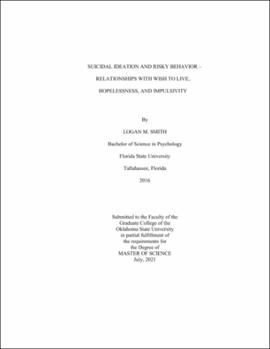| dc.contributor.advisor | Wells, Tony | |
| dc.contributor.author | Smith, Logan M. | |
| dc.date.accessioned | 2022-01-21T19:33:58Z | |
| dc.date.available | 2022-01-21T19:33:58Z | |
| dc.date.issued | 2021-07 | |
| dc.identifier.uri | https://hdl.handle.net/11244/333835 | |
| dc.description.abstract | Numerous studies have found support for the relationship between suicide and risky behavior. However, few studies have examined factors that may help explain the relationship between suicidal ideation and risky behavior. This study examined the relationship between suicidal ideation and risky behavior and whether there may be an indirect relationship through low wish to live, hopelessness, or impulsivity. We tested five hypotheses: (1) suicidal ideation would be positively associated with risky behavior; (2a) wish to live would be negatively associated with suicidal ideation and (2b) negatively associated with risky behavior; (3a) hopelessness would be positively associated with suicidal ideation and (3b) positively associated with risky behavior; (4a) impulsivity would be positively associated with suicidal ideation and (4b) positively associated with risky behavior, and there would be indirect relationships of suicidal ideation on risky behavior through (5a) wish to live, (5b) hopelessness, and (5c) impulsivity. Two hundred eighty-four participants recruited from Amazon Mechanical Turk completed measures of suicidal ideation, risky behavior, wish to live, hopelessness, impulsivity, and other related constructs. Results supported the majority of our hypotheses, with hypothesis 5b being the only hypothesis with null results. Our findings fit with our conceptual understanding that suicidal thoughts and behaviors may be associated with a decreased future orientation, as expressed through decreased wish to live and increased impulsivity. All of the factors investigated in this study have been reliably associated with suicidal thoughts and behaviors, but our study is the first to find associations between wish to live and risky behavior and hopelessness and risky behavior. These findings have important implications for models of suicidal thoughts and behaviors and offer some of the first data directly testing the relationship between some of these constructs. | |
| dc.format | application/pdf | |
| dc.language | en_US | |
| dc.rights | Copyright is held by the author who has granted the Oklahoma State University Library the non-exclusive right to share this material in its institutional repository. Contact Digital Library Services at lib-dls@okstate.edu or 405-744-9161 for the permission policy on the use, reproduction or distribution of this material. | |
| dc.title | Suicidal ideation and risky behavior - Relationships with wish to live, hopelessness, and impulsivity | |
| dc.contributor.committeeMember | Sweatt, Stephanie | |
| dc.contributor.committeeMember | Wingate, LaRicka R. | |
| osu.filename | Smith_okstate_0664M_17336.pdf | |
| osu.accesstype | Open Access | |
| dc.type.genre | Thesis | |
| dc.type.material | Text | |
| thesis.degree.discipline | Psychology | |
| thesis.degree.grantor | Oklahoma State University | |
